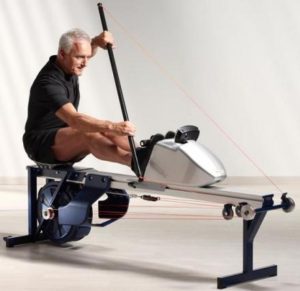Olympic Triathlon Training Myth #1. Paddles and Fins Are For Making Your Muscles Stronger.
Contrary to popular belief, paddles should not be used to make your swimming muscles “stronger” or increase the force of the water against your hand. Furthermore, water is a fluid medium and doesn’t “tear” muscle fibers, which means you’re not going to grow new muscle by using paddles. They should instead be used to enhance your feel for the water.
By increasing the surface of your hand, a paddle instead allows you to have a better idea of where your hand is as it enters the water and initiates the pull. I am personally a fan of the Finis Freestyle paddles, because they help direct your entire arm into a high-elbow position, which is ideal.
In the same way that paddles should not be used as merely a form of strength-training in the water, fins should not be used simply to make the legs more tired while you’re kicking. Instead, fins should be used to enhance your feel for the water, and should be used to encourage you to keep your legs relatively straight, kicking from the hips rather than the knees. Because they tend to give you a good feel during both the up and down portion of the kick phase, I am a fan of the Zoom H2 fins.
Olympic Triathlon Training Myth #2: You Should Wear Your Wetsuit the Same Way As Your Pants And Coat.
The biggest mistake a triathlete can make when putting on a wetsuit is to pull the sleeves and legs too far down the extremities, the same way they would put on their pants and coat. This mistake results in inadequate rubber left for the chest and shoulders, and a feeling of tightness, lack of mobility, and shortness of breath. Instead, the wetsuit sleeves should be pulled several inches up from the hands, and the wetsuit legs should be pulled several inches up from the ankles.
To more quickly and efficiently enter the wetsuit, wear socks or plastic bags over the feet. For both wetsuit entry and wetsuit exit, use a sports lubrication (such as BodyGlide) on the hands and feet. For a fast wetsuit exit, be sure to have the wetsuit rolled down to your waist by the time you enter bike transition, and practice exiting your wetsuit while in a standing position.
Olympic Triathlon Training Myth #3: To Be A Better Swimmer, You Don’t Need To Use “Toys” In The Water.
You should certainly learn to swim without the use of accessories, but they do have a proper place in the pool. In addition to paddles and fins, a few other useful pool accessories we encourage our athletes to use are: A) a waterproof swimming metronome to assist with rhythm, turnover and pace; B) an old bicycle tube to tie the ankles together and teach how to eliminate “runner’s kick“; C) tennis balls or round paddles to learn how to use the hands less and the forearms more; D) a short pvc pipe for practicing the ‘catch-up’ drill, in which the pvc pipe is handed from one hand to the other when both arms are extended in front of the body.
Olympic Triathlon Training Myth #4: You Have To Shave Your Body To Do A Triathlon.
Whole body shaving can reduce turbulent flow of the water against the skin, and assist with a quick wetsuit exit both of which can shave a few seconds from your time thus making whole body shaving a good choice for an elite athlete or individual who wishes to gain as many advantages as possible. But it might be a waste of time and razors if you’re just getting into triathlon.
However, shaved arms and legs can assist with ease of cleaning wounds from bicycle crashes. Waxing can be expensive, and razor can be be time-consuming, so both have their disadvantages! So if you do decide to keep yourself trimmed (especially you guys), we advise an electric razor for the initial shave, followed by a three or four blade handheld razor, used along with a good shaving cream.
Olympic Triathlon Training Myth #5: There Isn’t A Big Difference Between A Road Bike With Aerobars and a Tri Bike With Aerobars.
A short summary of the difference between a road bike and tri bike is as follows: The road bike geometry is designed for an upright riding position and greater utilization of the gluteus and hamstring muscles, which is not ideal for aerodynamics or running off the bike. The steeper aero bike geometry results in greater aerodynamic advantages and quadriceps utilization, both of which are crucial for time trialing and running off the bike.
Olympic Triathlon Training Myth #6: Fancy Bike Shoes Are Only For the Pros.
The “fancy bike shoes” have cleats on the bottom, and these cleats allow you to clip your feet into your bike pedals. When your feet are “clipped in“, you can generate more power and speed, because you are pulling up on the pedals with each stroke. In addition, bike shoes have a more firm sole, resulting in greater foot comfort and distribution of forces across the entire foot, especially when compared to cycling in relatively softer soled running shoes. So if you begin early by learning how to use the bike shoes, you give yourself an enormous advantage.
Olympic Triathlon Training Myth #7: Any Wetsuit Will Do.
Because of the thicker rubber and fewer areas of thin or flexible paneling, a surfing wetsuit can severely affect your ability to rotate your shoulders properly and to swim with an efficient freestyle stroke. Triathlon wetsuits were designed with an enormous focus on allowing a triathlete to swim efficiently and comfortably. So while a surfing wetsuit will offer the same degree of warmth as a triathlon wetsuit, it could actually slow you down more than simply not wearing a wetsuit at all!
 Paddle Weekend Your Paddle Weekend
Paddle Weekend Your Paddle Weekend
